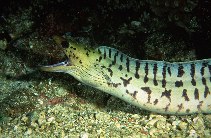| Family: |
Muraenidae (Moray eels), subfamily: Muraeninae |
| Max. size: |
93.4 cm TL (male/unsexed); 87.2 cm TL (female); max.weight: 1,463.6 g; max.weight: 1,169.3 g |
| Environment: |
reef-associated; brackish; marine; depth range 7 - 50 m |
| Distribution: |
Indo-Pacific: Madagascar (Ref. 33390) to the Society Islands, north to southern Japan (Ref. 559), south to Queensland, Australia; throughout Micronesia. |
| Diagnosis: |
Vertebrae: 128-142. Adults pale with small black spots on face; black spots proportionally much larger in young (Ref. 30404).
Description: Characterized by generally pale tan or greyish brown color; frequently with yellow hue on head; highly variable pattern of widely spaced, irregular dark brown to black spots and partial bars on body and fins; body depth at gill opening 14-18 in TL; high dorsal fin; dorsal fin origin slightly anterior to gill opening; anus slightly anterior to middle of body; narrow jaws, lower slightly curved; front jaw teeth in single row; anterior canines of upper jaw alternating with small pointed teeth; short inner row of canines at side of upper jaw; two pairs of elongate canines anteriorly in lower jaw (Ref. 90102). Predrosal vertebrae 4-5 (Ref. 92337). |
| Biology: |
Occurs in lagoons, reef flats and seaward reefs (Ref. 1602, 48635). Prefers protected inshore waters among dead corals, common in harbors and small caves (Ref. 30404). Probably nocturnal (Ref. 1602). Feeds on fishes and crustaceans (Ref. 9710). Possibly a protogynous hermaphrodite (Ref. 32169). Current age of a captive individual is 18 years, which exceeds 100 cm and approximately 10 lbs (owner Mark Palermo, pers. comm. 07/12). |
| IUCN Red List Status: |
Least Concern (LC); Date assessed: 17 August 2011 Ref. (130435)
|
| Threat to humans: |
harmless |
Source and more info: www.fishbase.org. For personal, classroom, and other internal use only. Not for publication.

